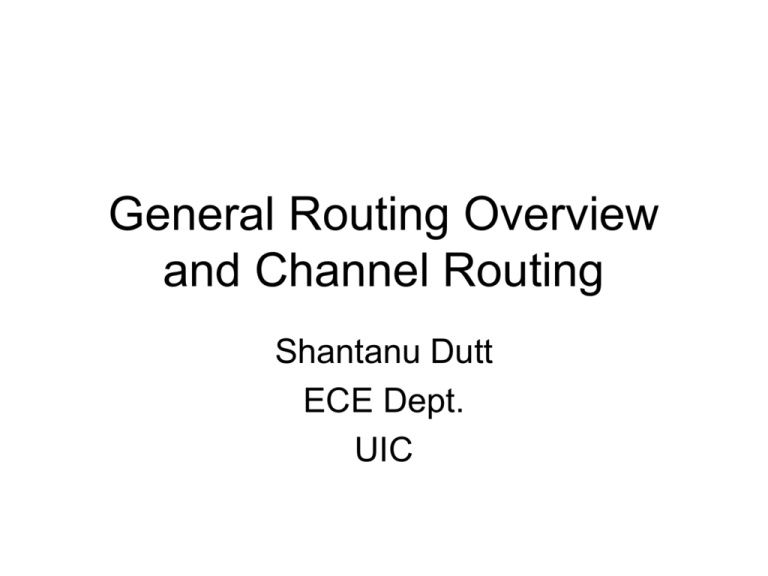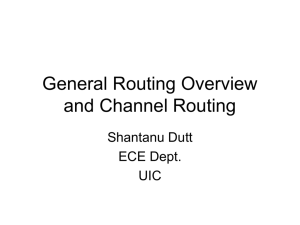Channel Routing
advertisement

General Routing Overview and Channel Routing Shantanu Dutt ECE Dept. UIC References and Copyright (cont.) • Slides used: (Modified by Shantanu Dutt when necessary) – [©Sarrafzadeh] © Majid Sarrafzadeh, 2001; Department of Computer Science, UCLA – [©Sherwani] © Naveed A. Sherwani, 1992 (companion slides to [She99]) – [©Keutzer] © Kurt Keutzer, Dept. of EECS, UC-Berekeley http://www-cad.eecs.berkeley.edu/~niraj/ee244/index.htm – [©Gupta] © Rajesh Gupta UC-Irvine http://www.ics.uci.edu/~rgupta/ics280.html – [©Kang] © Steve Kang, UIUC http://www.ece.uiuc.edu/ece482/ – [©Bazargan] © Kia Bazargan Routing • Problem – Given a placement, and a fixed number of metal layers, find a valid pattern of horizontal and vertical wires that connect the terminals of the nets – Levels of abstraction: • Global routing • Detailed routing • Objectives – Cost components: • Area (channel width) – min congestion in prev levels helped • Wire delays – timing minimization in previous levels • Number of layers (fewer layers less expensive) • Additional cost components: number of bends, vias ©Bazargan Routing Anatomy 3D view Top view Symbolic Layout Metal layer 3 Via Metal layer 2 Metal layer 1 Note: Colors used in this slide are not standard ©Bazargan Global vs. Detailed Routing • Global routing – Input: detailed placement, with exact terminal locations – Determine “channel” (routing region) for each net – Objective: minimize area (congestion), and timing (approximate) • Detailed routing – Input: channels and approximate routing from the global routing phase – Determine the exact route and layers for each net – Objective: valid routing, minimize area (congestion), meet timing constraints – Additional objectives: min via, power Figs. [©Sherwani] Taxonomy of VLSI Routers Routers Global Graph Search Detailed Restricted Steiner Iterative Maze Hierarchical Specialized General Purpose River Maze Switchbox Line Probe Channel Line Expansion Greedy Power/Gnd Clock Left-Edge [©Keutzer] Global Routing • Stages – Routing region definition – Routing region ordering – Steiner-tree / area routing • Grid – Tiles super-imposed on placement – Regular or irregular – Smaller problem to solve, higher level of abstraction – Terminals at center of grid tiles • Edge capacity – Number of nets that can pass a certain grid edge (aka congestion) – On edge Eij, Capacity(Eij) Congestion(Eij) • Steiner routing is generally performed on the routing graph using edge lengths as cost and considering edge capacities [©Sarrafzadeh] M2 M1 M3 Grid Graph • Course or fine-grain • Vertices: routing regions, edges: route exists? • Weights on edges – How costly is to use that edge – Could vary during the routing (e.g., for congestion) – Horizontal / vertical might have different weights t1 t2 t3 t4 t1 t2 1 t1 t2 t3 2 t4 1 t3 t4 1 2 1 1 1 1 1 [©Sherwani] Global Routing – Graph Search • • • • • Good for two-terminal nets Build grid graph (Coarse? Fine?) Use graph search algorithms, e.g., Dijkstra Iterative: route nets one by one How to handle: – Congestion? – Critical nets? • Order of the nets to route? – Net criticality – Half-perimeter of the bounding box – Number of terminals ©Bazargan (2-side routing, solvable optimally in linear time w/o vertical constraints) switch-boxes (maroon) in rest if the areas (4-side routing, requires Steiner channels (blue) covering adjacent routing, NP-hard) overlapping module boundary pairs ©Dutt for channel & sw-box definition in the left figure • A cycle in the VCG an unroutable placement unless a net can be routed on more than 1 track • Otherwise, depth of VCG is lower bound on channel density Optimality of the Left Edge Algorithm Case 2b: Case 2a: Closest non-ov net to e crosses L s(e) Closest non-ov net to e does not cross L e(e) e: Most recently e: Most recently routed net routed net e’ s(e’) s(e’) e’ S(L) L Case 1: Max density line L cuts e L’ L Case 2: Max density line L does not cut e • In Case 1, the density of L reduces by 1 after current track t (e is on t) is routed • In Case 2, let e’ be the net not overlapping e & whose s(e’) is closest to e(e). • Case 2a: If e’ crosses L, then since e’ will be on t, density of L reduces by 1 after t is routed • Case 2b: If not, then the set S(L) of all other nets crossing L are overlapping w/ e (otherwise one of them will be e’ and crossing L, and we will not be in Case 2b). Then there exists another cut line L’ that cuts S(L) and e, and thus have density > density of L, and we reach a contradiction (that L is the max density line) • Thus after current track t is routed, the density of L reduces by 1. This applies to all max density lines. Thus # of tracks needed = density of initial max density line which is a lower bound on # tracks. Hence the Left-Edge algorithm is optimal in the # of tracks ©Dutt Update the VCG by deleting all Ij ‘’s (and their arcs) routed in track t-1 > 0; (no arcs in the VCG incoming to Ij) Acyclic VCG Cyclic VCG 1a a 2 b 1b w/ the added flexibility that the new net e’s s(e’) can be = watermark if current net e and e’ belong to the same net







